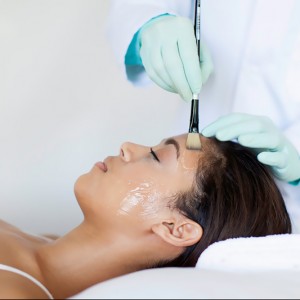Peels
Intended to combat skin ageing, dermatological peels are reserved for medical use, carried out in a doctor’s surgery or a centre for aesthetic medicine.
 Specialist doctors have long used peels to provide natural exfoliation of the skin, stimulated by a chemical solution. It is a safe, common practice. The uppermost layers of the epidermis are eliminated, leaving the skin looking healthier and less wrinkled. The active ingredients, amount applied to the face, application mode and time in contact with the skin are all factors that influence the success of the peel. The doctor applies a chemical solution, whose concentration depends on the effect required, to the face, neck, neckline or hands. This treatment is recommended for three main skin indications: premature ageing of the skin, discolourations and melasma, and acne. There are few contraindications for this technique.
Specialist doctors have long used peels to provide natural exfoliation of the skin, stimulated by a chemical solution. It is a safe, common practice. The uppermost layers of the epidermis are eliminated, leaving the skin looking healthier and less wrinkled. The active ingredients, amount applied to the face, application mode and time in contact with the skin are all factors that influence the success of the peel. The doctor applies a chemical solution, whose concentration depends on the effect required, to the face, neck, neckline or hands. This treatment is recommended for three main skin indications: premature ageing of the skin, discolourations and melasma, and acne. There are few contraindications for this technique.
Prior treatment at home is essential before a peel to prepare the skin 15 days before the first session. This protocol also enables verification of the absence of any allergy risk.
There are 3 types of peel:
- Superficial peels:
Superficial peels are mild, rapid and simple. The AHA peel (alpha hydroxy acid), also called the “lunchtime peel”, offers a real renewal effect and smooths the skin. It is painless, involves little or no desquamation and is suitable for all skin types.
The main component is glycolic acid, extracted from sugar cane, and several other acids of fruit or plant origin. Glycolic acid can be associated with active de-pigmentation ingredients and powerful antioxidant vitamins to optimise the peeling action. Associated with ascorbic acid or vitamin C, known for its lightening properties, it prevents the excessive formation of melanin.
This treatment eliminates dead skin and accelerates cell renewal. You may experience a slight prickling sensation during application. The skin may redden but this soon disappears. It costs around €70€ to 120€ for a 20-minute session.To ensure a lasting effect, several sessions are required: 4 sessions at two-week intervals, with a skin preparation protocol 15 days prior to the first peel. It is recommended to apply sun cream (FPS 30) during the first few weeks after the peel. - Medium-strength peels:
Medium strength peels act on the dermis. They enable acceleration of the cellular renewal process and stimulate collagen production. This type of peel is for skins marked by wrinkles and/or discoloured imperfections. The main component used is trichloracetic acid. It improves the texture of the skin, eliminates spots, reduces wrinkles and firms the tissues.
Sessions last approximately 20 minutes and application induces a sensation of heat. The skin feels tight for 48 hours. A period of desquamation lasting 2-3 days reveals the renewed, rejuvenated skin. It takes between 5 and 7 days with daily moisturising before the skin is completely restored.
For optimal results, between 1 and 4 sessions are required, accompanied by a treatment protocol at home. High-factor sun cream must be used to protect the skin throughout the treatment period and for at least one month after the peel.
After the treatment, the skin looks brighter and smoother and any wrinkles and imperfections will have been reduced. - Deep peels:
Deep peels act on the quality of the dermis. The resulting skin rejuvenation is spectacular. Only skin specialists, with several years’ experience with this technique, can do deep peels. The active ingredient of this type of peel is phenol. It enables correction of marked ageing of the skin with many, deep wrinkles due to external influences.
The session lasts around 1 hour, which is longer than superficial and medium-strength peels. A burning sensation will be felt for around ten seconds. After the session, there will be an 8-day period of desquamation and downtime.
A single session is generally sufficient. The result is generally spectacular, eliminating wrinkles and lines, leaving the skin toned and smooth.
The skin remains red for several days and sun cream is essential during the weeks after the peel.

